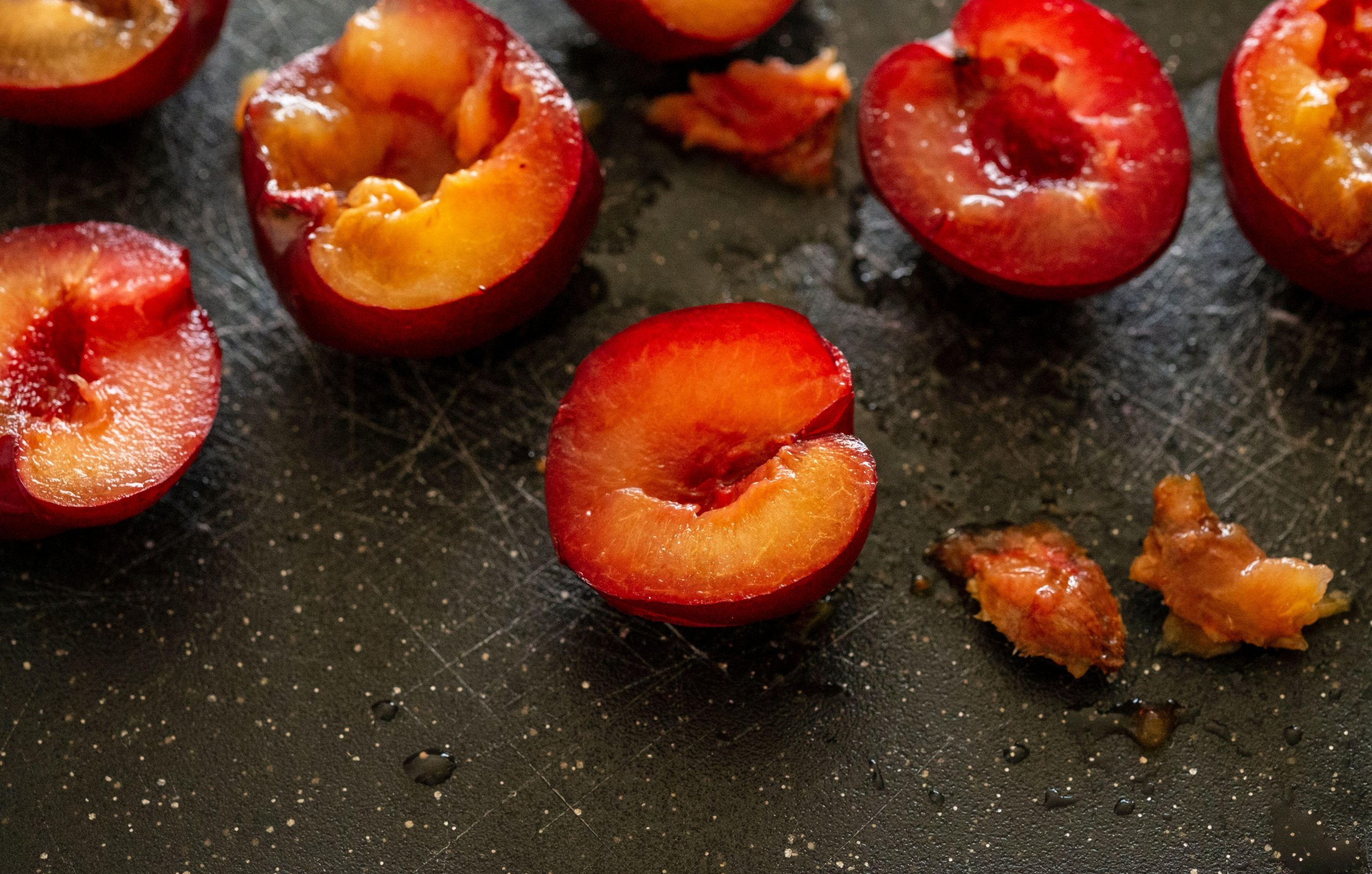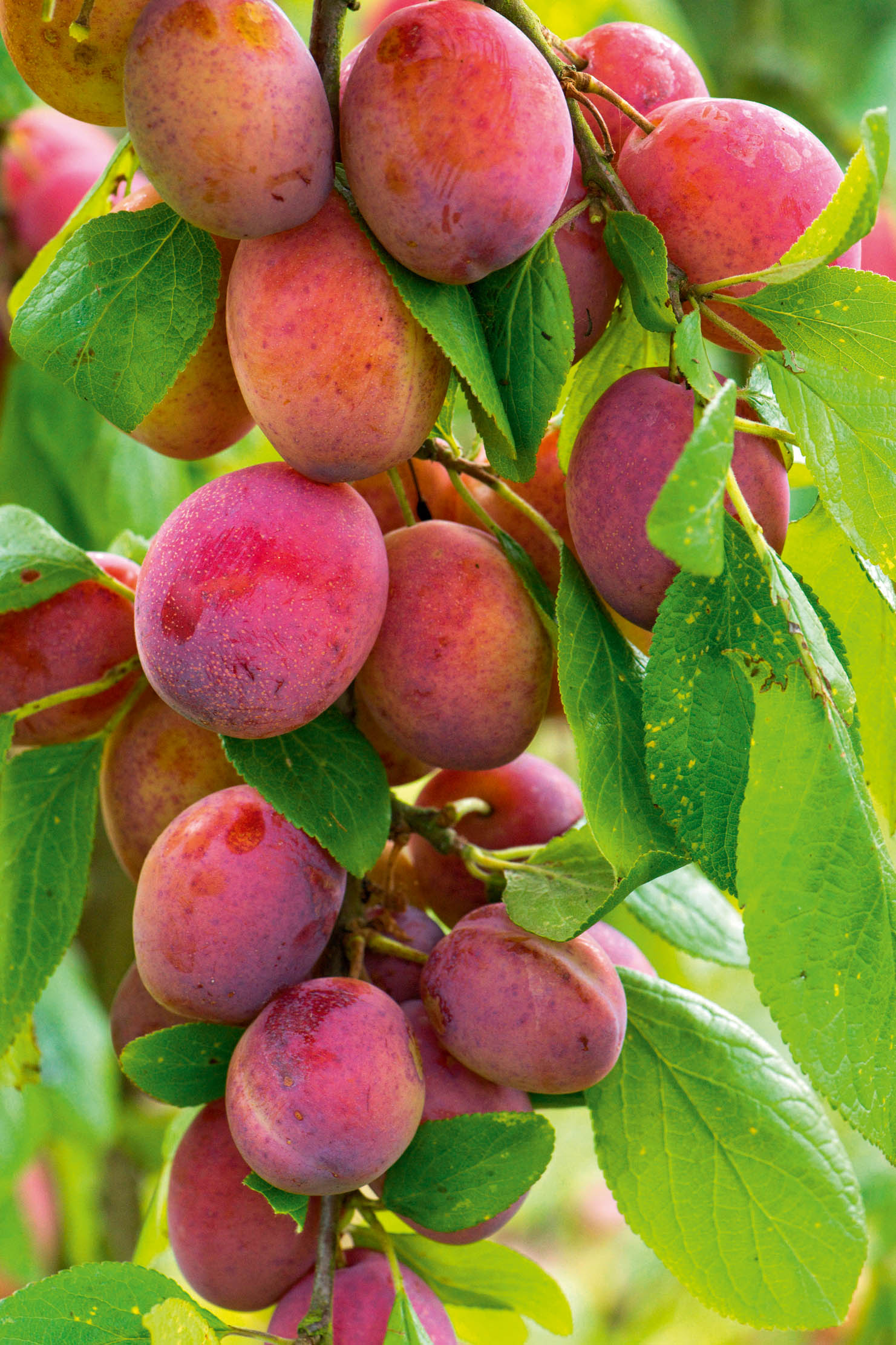The best way to enjoy plums, according to Tom Parker Bowles
For Tom Parker Bowles, nothing beats devouring a freshly- picked and sun-warmed plum in a shady sylvan bower, with the juice dribbling down his chin.


Ingens turba prunorum,’ sighed Pliny the Elder in his Natural History, describing ‘the enormous crowds of plums’ in a lush Roman garden. Because, among his accounts of ‘Sea Monsters of the Indian Ocean’, the ‘Combat of Elephants’, ‘Instances of Extraordinary Strength’ and ‘When Barbers were First Employed,’ he describes fruits of black, white and ‘parti-coloured’ the Armenian, and the ‘Barley’, the damson from Damascus, the ass, the wax, ‘esteemed cerina’, even the amygdalina, a possibly fabulous combination of almond and plum. An abundance of juice-heavy delight, of hue, scent, size and flavour, a fecund, fructuous low hanging feast.
Fast forward a couple of millennia, into the supermarkets and greengrocers of the 21st century AD, and things are not quite as bountiful. In fact, you’ll be lucky to find more than one variety, invariably the all-conquering Victoria, named after the Empress of India.
First developed in 1840, from a stray seedling found in Sussex, it was unleashed upon the world by a Brixton nurseryman. And, although the Victoria plum may ripen to a suitably regal purple, it was designed for canning, rather than eating raw. Reliable, relatively easy to grow and all but ubiquitous, ‘the apotheosis of a long reign is’, according to Jane Grigson, ‘a flood of bland, boring plums’.
The venerable Mrs G may be a trifle harsh. They don’t actually offend, as does the Dutch hydroponic tomato or mass-market strawberry. In some cases, they can be perfectly pleasant. However, compared with the lusciously buxom charms of the legendary Coe’s Golden Drop, say — a plum described by Jervaise Coe, its creator, as having a rather tough skin ‘but between this and the stone floats an ineffable nectar’ — the Victoria is the dour Governess, all hobnail boots and purse lipped prurience.

It does seem a shame that we find ourselves stuck in this Victorian cul-de-sac. Brogdale, that wonderful Kentish home of the National Fruit Collection, has a staggering 332 different varieties of plums, where the likes of Bryanston Gage, Ditsum Ploughman, Golden Monarch, Laxton’s Bountiful and Valor taste as beguiling as they sound. Originally from Asia (although wild plums were found throughout the northern hemisphere), plums were first cultivated in China and found their way west, probably with the help of Crusaders returning from Syria.
Closely related to the cherry, peach and sloe, the family also includes the greengage, which is simply a plum of different hue. ‘The distinction between a “Gage” and a plum is only British,’ writes Edward Bunyard in The Anatomy of Dessert. He had little time for any plum ‘encased in red, black or blue’, seeing the yellow- or green-skinned beauties as markedly superior.
The greengage certainly has a noble lineage. Reine-claude, the original variety, was named after Claude, wife of François I and daughter of Louis XII. She grew the trees, and gave them to anyone who asked, making her a true plum philanthropist. Sir William Gage brought a few specimens back to England in 1724, but lost the original labels (‘A plum role’, April 27). Hence the Green Gage plum.
Sign up for the Country Life Newsletter
Exquisite houses, the beauty of Nature, and how to get the most from your life, straight to your inbox.
I like mine baked into crumbles or stewed slowly with sugar, as in the recipe below. A plum sorbet can be very fine indeed, too. They make a fine sauce for Chinese roast duck and an icy glass of vieille prune is a digestif of true majesty. Nothing, however, can beat devouring them, freshly picked and sun-warmed, in some shady sylvan bower, the juice dribbling down one’s chin. That, for me, is the plummest bite of all.
Recipe: Prugne Al Forno
Alastair Little, who died in August, was not only a brilliant cook, but one of the most important culinary figures of the past half century. He was an incredibly nice man, too. Alongside the likes of Rowley Leigh and Simon Hopkinson, he stripped away much of the pomp and circumstance of restaurant dining. Bare tables, paper napkins, writing a daily menu based on what was best, that morning, from his suppliers. And an absolute belief in keeping it simple. This recipe comes from Italian Kitchen, a lovingly splattered, well-thumbed classic.
Ingredients
Serves 10
- 1½kg plums (not small ones such as Mirabelles)
- 750g caster sugar
Method
Preheat the oven to 150˚C/300˚F/gas mark 2.
Slice each plum in half along the seam, being careful to cut to the stone. Wrench gently apart and remove the stone. Put the fruit in a large bowl. When they are all prepared, add the sugar and mix thoroughly.
Arrange the plum halves in your selected baking dish, stacking them on their sides, propping each other up. Add any sugar remaining in the bowl. Cut some greaseproof paper to fit inside the baking dish and cover the plums. Your baking dish must be big enough to hold the fruit in one layer. Bake in the oven for 45 minutes. Do not touch, shake or stir. Remove from the oven and set aside to cool. Be careful; the sugary juices are above boiling point and will redefine pain if slopped onto your hand. It is very important that you do not try to do anything to the plums until they are cold or they will break up; indeed, they are better left in their baking dish and served from this.
Serve with an almond tart and whipped cream. If you want, a blob of mascarpone would provide an even richer alternative to cream.
Tom Parker Bowles is food writer, critic and regular contributor to Country Life.
-
 Designer's Room: A solid oak French kitchen that's been cleverly engineered to last
Designer's Room: A solid oak French kitchen that's been cleverly engineered to lastKitchen and joinery specialist Artichoke had several clever tricks to deal with the fact that natural wood expands and contracts.
By Amelia Thorpe
-
 Chocolate eggs, bunnies and the Resurrection: Country Life Quiz of the Day, April 18, 2025
Chocolate eggs, bunnies and the Resurrection: Country Life Quiz of the Day, April 18, 2025Friday's quiz is an Easter special.
By James Fisher